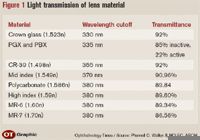Article
Knowing how lenses work can better protect patients' vision
Have you ever heard the phrase, "What you can't see won't hurt you"? When it comes to the electromagnetic spectrum, "what you can't see can hurt you."
Have you ever heard the phrase, "What you can't see won't hurt you"? When it comes to the electromagnetic spectrum, "what you can't see can hurt you."

Lenses absorb light differently. Special lenses that are designed to filter specific portions of light are called absorptive lenses. These lenses are often thought of for the purpose of fashion, but can be used to serve different functions such filtering ultraviolet (UV) light, blue light (linked to causing AMD, or age-related macular degeneration), infrared radiation, protection from glare, and more.
Light travels in a transverse wave motion and is measured in nanometers (nm), or a billionth of 1 meter. One wavelength is the distance from crest to crest of a constant wave cycle in phase (moving in the same direction).

Visible light (light energy that can be detected by the human eye) also is known as white light, which is measured from about 380 to 760 nm. Actually, the term white light is a misnomer. In fact, light is formed by a series of colors; red (620 to 760 nm), orange (590 to 620 nm), yellow (560 to 590 nm), green (490 to 560 nm), blue (450 to 490 nm), indigo (450 to 430 nm), and violet (380 to 430 nm). The human eye is most sensitive to the yellow/green region of light.
Individual colors of light cannot be seen independently because they are traveling at the same velocity through air. Therefore, light appears colorless or transparent to the human eye.
Light transmission of lenses
It is impossible for any lens to transmit 100% of available light. Some of the light is lost in the form of reflections, some light is absorbed, and the remainder is refracted, then transmitted through the lens.
A spectrometer is an instrument that not only measures but also displays the transmission curves (portion of light transmitted through the lens in nanometers) of both UV (percentage of UV light transmitted through the lens) and visible light.
Several factors affect light transmittance through lenses, such as the density of the lens material (refractive index), lens thickness, color and density of tints, UV absorbers applied to the lens, and other factors.
UV radiation and blue light
Newsletter
Don’t miss out—get Ophthalmology Times updates on the latest clinical advancements and expert interviews, straight to your inbox.




